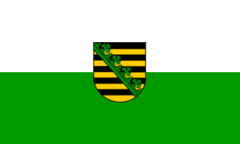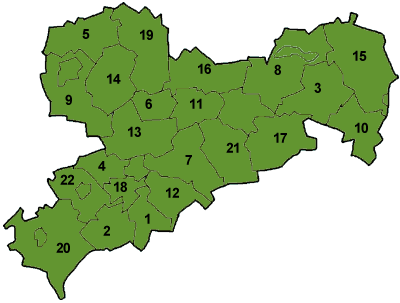Saxony
|
|
| State Service Flag | |
|---|---|
 | |
| Civil Flag | |
 | |
| Statistics | |
| Capital: | Dresden |
| Area: | 18,413 km² |
| Inhabitants: | 4,300,000 (2004) |
| pop. density: | 234 inh./km² |
| Homepage: | sachsen.de (http://www.sachsen.de/) |
| ISO 3166-2: | DE-SN |
| Politics | |
| Minister-president: | Georg Milbradt (CDU) |
| Ruling party: | CDU/SPD |
| Map | |
Missing image Germany_Laender_Sachsen.png | |
With an area of 18,413 km² and a population of 4.3 million, the Free State of Saxony (German: Freistaat Sachsen; Sorbian: Swobodny Stata Sakska) is the tenth-largest in area but sixth in population among Germany's sixteen federal states. Re-established upon Germany's reunification in 1990, it occupies the approximate area of the former kingdom (until 1918) of the same name. Dresden serves as the capital city.
In the early Middle Ages the term Saxony referred to a different region, occupying today's states of Lower Saxony and Bremen and the northern (Westphalian) part of North Rhine-Westphalia. The Saxons had migrated there from the area of present-day Schleswig-Holstein between 250 AD and 500 AD. See the history section below.
| Contents |
Geography
Saxony borders, from the east and clockwise, on Poland, the Czech Republic and the German states of Bavaria, Thuringia, Saxony-Anhalt and Brandenburg. Its capital is Dresden, and the other principal cities are Leipzig and Chemnitz. Since 1989 the population of the state and its urban centers has diminished because of migration to the former West Germany.
The main axis of Saxony is the Elbe river, crossing the state from southeast to northwest. Another important river, west of the Elbe, is the Mulde. The Neiße river forms the Polish border. The portions in the east of Saxony are the southern parts of the historical region of Lusatia (Lausitz) and are called Upper Lusatia (Oberlausitz); the minority of the Sorbs live in the region, which is bilingual today.
The countryside rises gradually from north to south, culminating in the mountain ranges along the Czech border. The Ore Mountains (Erzgebirge) extend from Bavaria to the Elbe river. The Elbe itself has cut a majestic gorge to pass the mountains of the Elbsandsteingebirge, better known as Saxon Switzerland. Further east the mountains are less high and form a hilly countryside called the Lausitzer Bergland. See also List of places in Saxony.
Saxony is divided into 3 Regierungsbezirke - Chemnitz, Dresden, Leipzig - which are subdivided into 22 districts:
|
Furthermore there are seven independent towns, which don't belong to any district:
- Chemnitz S middle southern Saxony
- Dresden C capital
- Görlitz E didn´t belong to Saxony 1815-1945
- Hoyerswerda NE decided to accompany Saxony in 1990
- Leipzig NW biggest city of saxony
- Plauen W western Saxony
- Zwickau W western Saxony
History
Main article: History of Saxony
Prehistoric Saxony was the site of some of the largest of the ancient Central European monumental temples, dating from the 5th millennium BC. Notable archeological sites have been discovered in Dresden and the village of Aythra near Leipzig.
For the origins of the Saxon tribes see Saxons.
Foundation of the first Saxon state
The first Duchy of Saxony emerged about 700 AD in today's Lower Saxony and North Rhine-Westphalia. In the 10th century the dukes of Saxony were at the same time kings (or emperors) of the Holy Roman Empire (Ottonian or Saxon Dynasty). At that time, a Saxon noble family of Billungs received extensive fiefs in Saxony, and the Emperor eventually gave them the title of Duke of Saxony. After the extinction of the male line of Billungs, the duchy was given to Lothar of Supplinburg, who then also became Emperor for a short time.
In 1137 Saxony was passed to the Welfen dynasty, who were descendants (1) of Wulfhild Billung, eldest daughter of the last Billung duke, and (2) of the daughter of Lothar of Supplinburg. It reached its peak under Duke Henry the Lion, and after his death it began to decline (Henry had declined to participate the later Italian wars of his liege lord, Emperor Frederick Barbarossa, and those expeditions to Italy ended in distasters. The furious emperor retaliated and sent his troops to end duke Henry's dominion). In 1180 large portions west of the Weser were ceded to the bishops of Cologne, some central parts between Weser and Elbe remained to Welfs, later forming the Duchy of Brunswick-Lüneburg). The remaining Eastern lands, together with the title of Duke of Saxony, were passed to an Ascanian dynasty (who descended from Eilika Billung, Wulfhild's younger sister) and divided in 1260 into the two small states of Saxony-Lauenburg and Saxony-Wittenberg. Saxony-Lauenburg was later renamed Lauenburg and was no longer part of Saxony or its history. Saxe-Wittenberg was confirmed to have inherited the "main" ducal title of Saxons and as such was recognized as Elector of the Empire in 14th century.
Foundation of the second Saxon state
Saxony-Wittenberg, in present Saxony-Anhalt, became subject to the margravate of Meißen and ruled by the Wettin dynasty) in 1423. A new powerful state was established, occupying large portions of present Saxony, Thuringia and Saxony-Anhalt. Although the center of this state was far southeast of the former Saxony, it came to be referred to as Upper Saxony and then simply Saxony, while the former Saxon territories were now known as Lower Saxony.
In 1485, Saxony was split as a collateral line of the Wettin princes received what later became Thuringia and founded several small states there (see Thuringia). The remaining Saxon state became even more powerful, becoming known in the 18th century for its cultural achievements, although it was politically inferior to Prussia and Austria, which pressed Saxony from either side.
Saxony in the 19th and 20th centuries
With the abolition of the Holy Roman Empire in 1806, Saxony became a kingdom, and Elector Frederick Augustus III became King Frederick Augustus I. Frederick Augustus made the mistake of remaining loyal for too long to Napoleon I, and he was taken prisoner and his territories declared forfeit by the allies in 1813, with the intention of their being annexed by Prussia. Ultimately, the opposition of Austria, France, and Britain resulted in Frederick Augustus being restored to his throne at the Congress of Vienna, but Saxony was forced to cede the northern part of the kingdom to Prussia. These lands became the Prussian province of Saxony, which is today incorporated in Saxony-Anhalt. What was left of the Kingdom of Saxony was roughly identical with the present federal state.
During the 1848-49 constitutionalist revolutions in Germany, Saxony became a hotbed for revolutionaries, with anarchists such as Mikhail Bakunin and democrats including Richard Wagner and Gottfried Semper taking part in the May Uprising in Dresden in 1849.
After 1918 Saxony was a state in the Weimar Republic and was the scene of Stresseman's overthrow of the KPD/SPD led government in 1923, during the Nazi era and under Soviet occupation. It was dissolved in 1952, but reestablished in 1990 upon German reunification. Today Saxony also includes a small part of Silesia around the town of Görlitz which remained German after the war and which for obvious reasons of unviability as a separate state was incorporated into Saxony.
See also:
- Rulers of Saxony
- Ottonian dynasty
- Wettin dynasty
List of minister presidents of Saxony
For earlier rulers, see Rulers of Saxony.
- 1918 - 1919: Richard Lipinski (USPD)
- 1919 - 1920: Georg Gradnauer (SPD)
- 1920 - 1923: Wilhelm Buck (SPD)
- 1923: Erich Zeigner (SPD)
- 1923 - 1924: Alfred Fellisch (SPD)
- 1924 - 1929: Max Heldt (SPD)
- 1929 - 1930: Wilhelm Bünger (DVP)
- 1930 - 1933: Walter Schieck (no party)
- 1933 - 1935: Manfred Freiherr von Killinger (NSDAP)
- 1935 - 1945: Martin Mutschmann (NSDAP)
- 1945 - 1947: Rudolf Friedrichs (SPD, then SED)
- 1947 - 1952: Max Seydewitz (SED)
- 1990 - 2002: Kurt Biedenkopf (CDU)
- since 2002: Georg Milbradt (CDU)
External links
- Official governmental portal (http://www.sachsen.de/)
- Christmas time in Saxony (http://www.weihnachtsfreu.de)
ar:ساكسونيا cs:Sasko da:Sachsen de:Freistaat Sachsen et:Saksimaa es:Sajonia eo:Saksio fr:Saxe he:סקסוניה it:Sassonia la:Saxonia nl:Saksen (deelstaat) ja:ザクセン州 no:Sachsen nds:Sassen (Bundsland) pl:Saksonia pt:Saxônia ro:Saxonia ru:Саксония (федеральная земля) simple:Saxony sv:Sachsen zh:萨克森

